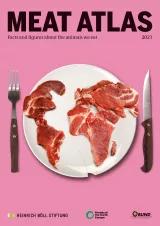
Across the globe, peatlands are being drained for farming and raising livestock. But dried-out peat emits huge amounts
of greenhouse gases. Agricultural policy should initiate the transformation to the climate-friendly use of these areas.

Over the millennia, waterlogged land has given rise to ecosystems that transform partly decomposed plant biomass into peat, and in doing so, store huge amounts of carbon in the ground. Although peatlands cover only 3 percent of the world’s land surface, they contain twice as much carbon as the biomass of all the forests which spread across 30 percent of world’s land. Natural wet peatlands are true multitalents. By filtering out nutrients and pollutants, they act as the “kidneys” of the landscape. They are important water reservoirs, and cool the surrounding area. Last but not least, they serve as a home for rare flora and fauna.
But peatlands have been, and still are being, drained in order to extract peat, to make the land usable for farming and forestry, and to gain new land for settlement. Permanently lowering the water levels allows air to penetrate the peat layers. The carbon these layers contain oxidizes and is emitted as CO2, exacerbating climate change. The peat is consumed in the process, and the surface of the land sinks: by 1–2 cm per year in Central Europe, and up to five times faster in the tropics. After hundreds of years of use, the surface of peatlands in the Netherlands now lies several metres below sea level. In dried-out peat layers, devastating fires may smoulder for months on end. Indonesia is known as the global hotspot with the highest CO2 emissions from peatlands, while the European Union is in second place. Within the EU, it is Germany, where 98 percent of peatlands have been drained, that accounts for the highest emissions.
Some 15 percent of the world’s peatlands have been drained, and half of those have been converted to agricultural use. Even though carbon-rich soils account for just 3 percent of the European Union’s agricultural area, their drainage is responsible for 25 percent of greenhouse gas emissions from agriculture and agricultural land use.
Most of the peatland soils drained for agricultural purposes in Europe are used for raising livestock. In some regions, such as southern Germany, Denmark, the United Kingdom and Switzerland, they are important for farming vegetables, potatoes and grains. In addition to being repurposed as meadows and pastures, peatlands are also used to grow fodder such as silage maize.
Dairy farms place high demands on the quality of their cattle feed, and especially on its energy content. The intensive use of peatlands for dairying is found in northwestern Germany, Finland, and especially in the Netherlands. The city of Gouda, which gave its name to the world-famous Dutch cheese, lies in the middle of a peat bog that was drained in the 11th century. With greenhouse gas emissions of 20 to 50 tonnes of CO2-equivalent per year, each hectare of intensive grassland and cropland on peat soils is especially damaging to the climate, and is also of negligible value in terms of biodiversity. These emissions increase the footprint of a kilogram of milk produced on peatland by 4 kilograms of CO2. That makes it around five times that of milk produced on mineral soils, which is between 0.6 and 1.5 kilograms a year. The higher footprint applies to other dairy products as well. For a kilogram of cheese, made from 9 litres of milk, the annual CO2 footprint is 45 kilograms, compared to 9 kilograms for non-peatland cheese. For a kilogram of butter, made from 18 litres of milk, it is 97 kilograms rather than 25.
For the productive and climate-friendly use of peatland areas, alternatives other than animal husbandry are needed. The answer may be “paludiculture” – from palus, the Latin word for swamp. Various types of plants are being tested that are suitable for cultivation on peatland sites that have been rewetted. Raw materials from paludiculture could contribute to the decarbonization of our economy. They include Sphagnum mosses, which can be grown on former bog grasslands, and which could replace peat being the predominant substrate in horticulture. Grasses and sedges from wet meadows can be used to produce fibre for paper and cardboard, disposable tableware and building panels. Reed and cattail can supply raw materials for construction and insulation.
In the European Union, it is the Common Agricultural Policy that determines whether peatlands are used in a manner that is both climate-compatible and socially acceptable. Scientists and civil society organizations are largely in agreement that funding practices have a key role to play. Paludiculture and the periodic flooding of land could be supported in the future, while subsidies for draining peatlands should be withdrawn. Farms will need support to withstand such changes, starting with individual advice and investment, through to appropriate remuneration for their environmental and climate services. Protecting peatlands is not just the responsibility of individual farmers; it is a task for society as a whole.


